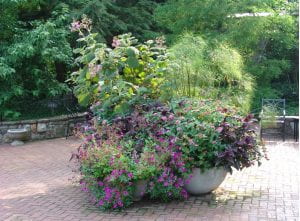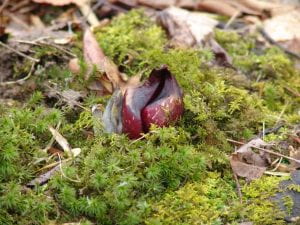If you filled your containers with pansies early this spring, they have provided lots of color but are starting to get a bit long in the tooth. It is time to pull the pansies out and plant containers for summer show.
Soils for containers must be well aerated and well drained while still being able to retain enough moisture for plant growth. Don’t use garden soil in your containers, it is too heavy and won’t drain properly. Purchase a soilless mix designed for use in containers. For succulents, herbs and perennials, select a coarse soilless mix with more bark, perlite or sand because these plants need good drainage and you don’t want the mix to retain moisture over long periods of time. For tropical and foliage plants, choose a media with more peat and less coarse material as these plants tend to prefer moister growing conditions. Moisten your media slightly before planting by filling a tub with media, adding water and mixing. Remember, containers must have a drainage hole.
Think of your container garden as a living flower (and foliage) arrangement. Include a tall plant in the center or back of the container. Select filler plants to provide interest and use cascading plants to soften the edges. Consider plant requirements when planning combination containers. Use all shade plants for shady locations and sun-loving plants on a sunny patio. If you use a combination of sun-loving and shade-loving plants in a single container, there will be no appropriate exposure for the container. Also, think about moisture requirements. Don’t combine plants that like it moist with plants that require good drainage. You can combine shrubs, perennials and annuals, but the annuals will need to be replaced the following year. Depending on the size of the container and exposure, the shrubs and perennials may overwinter in the container. Tropicals are fun to add in a combination container, but you will need to bring them indoors to survive the winter. If you combine a shrub and a tropical, you will have a conundrum—bring it in and the shrub will suffer; leave it outdoors and the tropical will die.
Ornamental sweet potato vine (Ipomoea butatas) is a great annual to use for summer containers. You can get chartreuse and black varieties that make a bold statement with flowering plants. They are spillers, that soften the edge of the container. Another good chartreuse plant for container gardens is hakone grass (Hakonechloa macra). Its arching, mounding habit will flow over the edge of the container. Euphorbia Diamond Frost (Euophorbia hypericifolia ‘Inneuphe’) is a great plant with a small white flower that blooms in profusion from spring to frost. It is a great filler in a container planting. Another good filler is sweet alyssum (Lobularia maritima). I planted some in a container near my carport and every time I get out of my car, I notice the sweet smell. Coleus comes is so many wonderful foliage colors these days and will do a great job of filling out a container.
For the tall statement plant in your container, consider papyrus (Cyperus papyrus) if you can keep it moist. Another moisture loving plant for the background is soft rush (Juncus effusus). For a dry container, use an ornamental grass like purple fountain grass (Pennisetum setaceum) or Mexican feather grass (Nassella tenuissima). You can even use the” impossible to kill” snake plant (Sansevieria laurentii) or ti plant (Cordyline fruticosa), both common houseplants.
Dusty miller (Jacobaea maritima) comes in different leaf forms and adds an eye-catching silver to the mix. All these plant suggestions and I haven’t even touched on flowers! Go to your local garden center and chose the flowers you like in the colors that match your outdoor décor.
Once you have selected your container, growing media and plants, fill the container (almost full) with media. Arrange the plants on the surface and play with the design until you are happy with the combination. Remove each plant from its plastic pot and loosen the roots, especially if they are circling within the container in which it was grown. Add a bit more media and water thoroughly. Watering after planting settles the media and eliminates air pockets. You may need to water several times to insure the media is thoroughly moist. Make sure water drains out of the hole in the bottom of the pot. A waterlogged container will not thrive unless you are growing water plants. Remember to water container plants frequently throughout the summer. Soilless media dries out more quickly than garden soil. Fertilize containers a few times during the summer. Annuals and tropical will need more frequent fertilization than shrubs and perennials.













